PENGARUH METODE THINKING ALOUD PAIR PROBLEM SOLVING (TAPPS) TERHADAP KEMAMPUAN KOMUNIKASI MATEMATIS SISWA SMP NEGERI 1 MANGGAR
Abstract
Mathematical communication skills are very important in mathematics learning, the reality in the field shows the mathematical communication skills of Indonesian students are still relatively low. One of the factors causing low mathematical communication skills is conventional learning. One alternative learning that can be used to improve mathematical communication skills is the TAPPS method. This study aims to investigate whether there are differences in the average mathematical communication skills of students who learn using the TAPPS method with students whose learning uses conventional learning. This research is a quantitative study with a quasi experiment method and post-test only equivalent non-group control design. The population in this study were 4 class VIII Manggar Middle School 1. The sample technique uses convenience sampling. The sample in this study were students VIII B was the experimental class and VIII A was the control class. based on data processing using the Mann-Whitney test obtained and so that it is received, it means that there is no difference in average communication skills between students who use the TAPPS method and students whose learning uses conventional learning. The average posttest results of the experimental class students were 63.7340 and the average posttest results of the control class were 53.8454.
Abstrak
Kemampuan komunikasi matematis sangat penting dalam pembelajaran matematika, kenyataan dilapangan menunjukan kemampuan komunikasi matemtatis siswa Indonesia masih tergolong rendah. Salah satu faktor penyebab rendahnya kemampuan komunikasi matematis adalah pembelajaran konvensional. Salah satu alternative pembelajaran yang dapat digunakan untuk meningkatkan kemampuan komunikasi matematis adalah metode TAPPS. Penelitian ini bertujuan untuk menyelidiki apakah terdapat perbedaan rata-rata kemampuan komunikasi matematis siswa yang pembelajarannya menggunakan metode TAPPS dengan siswa yang pembelajarannya menggunakan pembelajaran konvensional. Penelitian ini merupakan penelitian kuantitatif dengan metode quasi experiment dan desain non equivalent posttest only control group design. Populasi dalam penelitian ini adalah 4 kelas VIII SMP N 1 Manggar. Teknik sampel menggunkaan convenience sampling. Sampel pada penelitian ini adalah siswa VIII B merupakan kelas eksperimen dan VIII A merupakan kelas kontrol. berdasarkan pengolahan data menggunakan uji Mann-Whitney diperoleh tidak terdapat perbedaan rata-rata kemampuan komunikasi mateamtis antara siswa yang menggunakan metode TAPPS dengan siswa yang pembelajarannya menggunakan pembelajaran konvensional. Rata-rata hasil posttest siswa kelas eksperimen adalah 63,7340 dan rata-rata hasil posttest kelas kontrol adalah 53,8454.
References
Baswedan, Anies. "Peraturan Mentri Pendidikan dan Kebudayaan Nomor 21 Tahun 2016." 2016.
Benham, Harry. Using Talking aloud Pair Problem Solving to Enhance Student Performance in Produktivity Software Course. Issues Information Systems. Montana: Montana State University, 2009.
Fitriyani, Adelina. "Pengaruh Model Pembelajaran The Learning Cell Terhadap Kemampuan Komunikasi Matematis Siswa." Skripsi UIN Syarif Hidayatullah Jakarta, 2017.
Handayani, Laely Suci. "Pengaruh Think Aloud Pair Problem Solving (TAPPS) Terhadap Kemampuan Komunikasi Matematika Siswa SMA." Jurnal Pendidikan Matematika FMIPA UNP, 2014.
Jatmiko, M Anang. "Pengaruh Metode TAPPS Terhadap Kemampuan Komunikasi Matematik Siswa." Skripsi UIN Syarif Hidayatullah Jakarta, 2014.
John, Creswell. W. Research Design Pendekatan Kualitatif, Kuantitatif, dan Mixed. Yogyakarta: Pustak Pelajar, 2013.
Jonassen, David H. Learning to Solve An Instrutional Design Guide. San Fransisco: Pfeiffer, 2015.
Kartono, and Sunarmi. "Analisis Kemampuan Komunikasi Matematis Siswa Kelas VIII SMP Pada Model Pembelajaran TSTS Dengan Pendekatan Scientific." UJME Semarang, 2015.
Mahmuzah, R, and Aklimawati. "Pembelajaran Problem Posing Untuk Mengembangkan Kemampuan Komunikasi Matematis Siswa SMP." Didaktik Matematika, 2016: ISSN:2355-4185 Vol.3, No.2.
NCTM. Priciples and Standar For School Mathematics. The National Council Of Teacher Of Mathematics, 2000.
Nurhidayati, Fitriana. "Pengaruh Strategi Thinking Alod Pair Problem Solving (TAPPS) Terhadap Kemampuan Komunikasi Matematis dan Prestasi Belajar Siswa SMP." Skripsi UNY, 2017.
Polya, George. How To Solve It; A New Aspect of Mathematical Method. United States of America: Princeton University Press, 1973.
Septiana, Ria. "Efektivitas Model Pembelajaran Kooperatid Tipe Think Pair Share Ditinjau Dari Kemampuan Komunikasi Matematis Siswa." Universitas Lampung, 2017.
Sheskin, David j. Parametric and Nonparametric Statistical Procedures. New York: A CRC Press Company, 2004.
Stice, James E. "Teaching Problem Solving." Jurnal Chemical Engineering. The University of Tecas at Austin, 1987.



















